
|   |

|   |
36th Kathak Mahotsav - Tapati Chowdhurie e-mail: tapatichow@yahoo.co.in Photos courtesy: Kathak Kendra March 4, 2024 The super popular event of Kathak Kendra - formally inaugurated as a unit of Sangeet Natak Akademi in 1964 - is the Kathak Mahotsav which unfortunately had come to a halt. Thanks to the vision of Dr. Sandhya Purecha - Chairman of Sangeet Natak Akademi - who spotted Kathak exponent Uma Dogra to head the Advisory Board of the Kendra, within a short period of her taking over re-launched the mega festival after a hiatus of six years. Kathak Mahotsav was held at Kamani auditorium in New Delhi from 29th to 31st January 2024. Uma Dogra said, "The festival carries the promise of our unwavering commitment to Kathak and its kaleidoscope form closely guarding the purity of practitioners of the art form and its adaptability to the changing times." A dance festival's centre of attraction is mainly on performances. Uma Dogra's vision lay emphasis on inclusiveness. She coordinated with Pranaame Bhagwati - the Director of the Kendra's Advisory Board - and focussed mainly on Kathak practitioners of Bangalore followed by Kolkata, Pune, Ahmedabad, Mumbai and of course Delhi. Though on all the three days duet and group performances were featured, more importance was given to solo dancing. Two solo dancers were invited to perform on each of the three days to popularize it. The season opened with the solo performance of Sourav Roy, disciple of Malabika Mitra, who created an instant rapport with the rasikas with Adi Shankaracharya's Ardhanariswar. His was a complete package with taal Dhamaar in the nritta sequence. Thaat, layakaris, different types of paran and parmelu, such as Paran jodi aamad, paran with 51 spins, footwork in taal Dhamar was a delight. To showcase his ability in abhinaya, he selected Pt Lachchu Maharaj's powerful Kavit on Daksha Yagna, backing it up with his powerful dancing to the accompaniment of his Guru Malabika Mitra's full throated chanting. And in drut teentaal came a gat nikas on the three stages of Sri Krishna's life. As a little boy playing with his flute; the eternal lover Krishna summoning beautiful maidens with his compelling flute music and then delivering the profound words of the Gita to Arjun as his charioteer in the great battle of Kurukshetra rounding it off with some of the choicest bols from Lucknow Gharana and Jaipur Gharana. Aided by Subir Thakur on the tabla, Sunanda Mukherjee on sarod and vocalist Jayanto Banerjee, it had its required results. 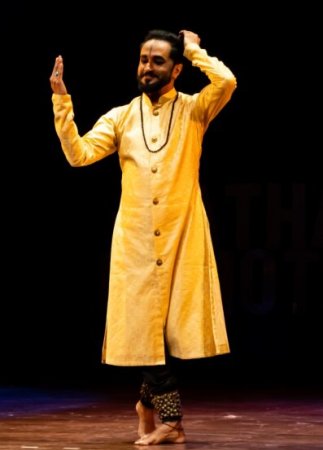 Sourav Roy 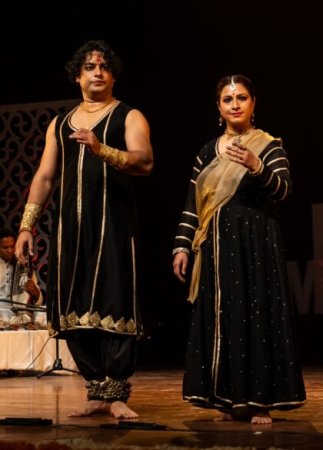 Piyush and Preeti Young dancers Piyush and Preeti from New Delhi, products of Kathak Kendra, paid their naman to the legendary lord of dance. Shiva Stuti was their starting point, before they switched over to the technicalities of Kathak. Their 'tayari' and power over layakari and the different aspects of the genre was amazing. They stole the hearts of the audience with their immense energy, perfection, speed, flawless chakkars and impressive tatkars with unmatchable synchronization. Frequent audience applause said it all. With their kind of potential, they will in time to come, improve on their costumes and mature towards more and more perfection. Samiullah Khan's vocal rendition alongside the percussionists Gangani brothers and bol-padhant of Amir Khan gave the program the required fillip. 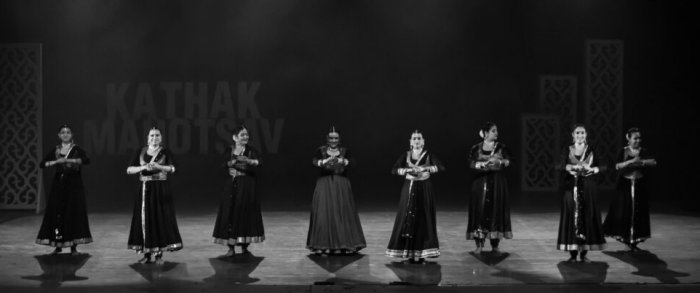 Gauri Sharma & group To Gauri Sharma Tripathi - the artistic director of Amara Nritya Kala Hansa and Ankh Dance UK- dance is visual poetry, which seamlessly bring together words, music, movement and prayers and the body is a moving temple that gives access to the divine. Gauri and Ankh ensemble peeled the layers of life within and the philosophy of the body and its relevance in the universe. She showcased the tradition of her parampara's upaj, unfolding the progression and movements within the Kathak dance grammar. Her group performed a Kirtan sung during Sharad Poornima in the temples of the Vaishnav Sampradayas and also during the Maharaas of Krishna and the gopis. According to the narrative, Radha and the gopis surround Krishna in the forest on the bank of River Yamuna, enchanted by his flute music and seeing their numbers Krishna manifests himself into many Krishnas. The theme was conceptualized by Gauri's mother and guru, Padma Sharma, who had performed this in 1965 as part of a musical choreographed by Pt. Lachchu Maharaj, "Gokul ki gali sankari", which was reworked by Gauri Sharma for the modern stage. The Kirtan was arranged by Hiren Chate, performed by Gauri Sharma Tripathi, Shalmali Zankar, Sneha Masurkar, Neeti Premkumar, Angira Kanwar, Pritha Chatterjee, Milky Jain and Tarini Tripathi. Daksha Yagna, Kavit by Pt. Lachchu Maharaj followed next. King Daksha had organized a huge yagna and had intentionally avoided inviting Shiva and Uma, his daughter. Ignoring social norms and her husband's wishes, she attended the ceremony only to be insulted by her father. Unable to bear it she jumped into the sacrificial fire. In deep grief and pain, Shiva took the half-burnt body of Sati and went round dancing the dance of destruction. Ultimately Lord Vishnu, says the legend, managed to calm Shiva. The story was relived beautifully by the troupe to the music composition of Niraj Chag. The next piece 'Sacred' explored man's journey for the divine, ignorant of the fact that the divine dwells within all human beings. This piece embraced oral legends, like Kabir, Bullehshah and Narsinh Mehta. The message of the piece, "Different energies lead to one path, one journey of life, in search of the Sacred". 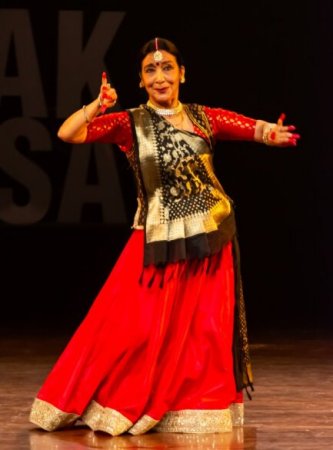 Durga Arya Durga Arya Kruger - one of the prime disciples of Pt Birju Maharaj - is a passionate Kathaka. She proved her mettle on the first evening of the festival. From the start to finish, her energy level was the same. "Gajamukh vadan lage ati sunder" penned and composed by Pt. Birju Maharaj was performed first before starting on Vilambit Teentaal with upaj, thaat, few uthans, both in ang form and footwork followed by aamad. The third piece was a Thumri, "Man mohan man bhaye mai" penned and composed by Pt Birju Maharaj. With her supporting musicians Ustad Shakil Ahmed Khan (tabla), Jay Dadhich (vocal), Janab Nasir Khan (sarangi) and Sunando Mukherjee (sarod), she seemed to have just warmed up, but the time on the clock belied and the audience was left hankering for more. She ended the first day's programme marvellously. Solo dancer Manisha Nayak inaugurated the second evening with her spirited solo. Like all devoted souls she paid her obeisance to Ganesha before commencing her recital. Her negotiation with the 14 beat taal Dhamar and the 16 beat teentaal one after the other was appreciated. Remarkably, of the 10 avatars of Vishnu, she had chosen to portray Kurma Avatar. 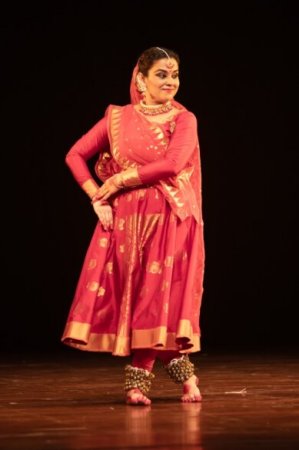 Manisha Nayak 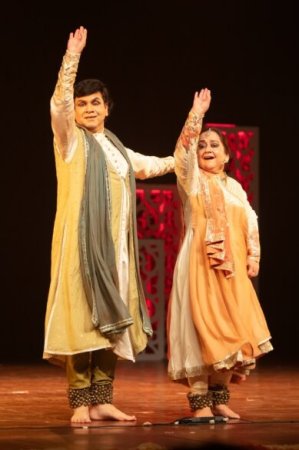 Maulik Shah and Ishira Parikh Maulik Shah and Ishira Parikh, the well-known Kathak couple from Ahmedabad, regaled the audience with their duet dancing with great elan. Taal Samanvay was rather unique. A parallel presentation of 2 taals - jhaptaal of 10 matra and Rudra taal of 11 matra creating a cohesive atmosphere had to be watched holding our breaths. Maintaining the characters of each taal created an engaging dimension. Rhythmic composition of the same bols like parans, tihais, thaat, tukdas etc looked strikingly different yet harmonious, keeping the mood of each taal intact. Lehra of each set a very positive mood. The highlight was the last footwork where the lehra kept changing from one to the other, culminating in a tihai. It was a combination of creativity and insight. The presentation began with a 'padh' to the glory of Shri Ram, "Raghav Raghurai, sukhdayi...." It was amply clear that excellence is in their blood. 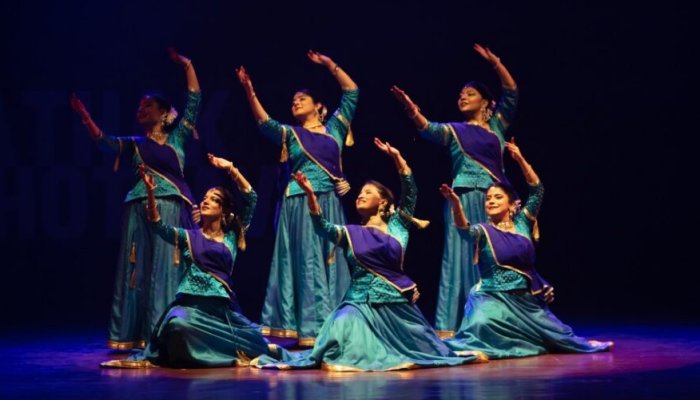 Pt Jai Kishan Maharaj's disciples Pt Jai Kishan Maharaj's repertory members performed Megh Malhar on recorded music. The imageries of the monsoon were recreated on stage impressively, whether it was just a drizzle taking you by surprise, or tiny drops turning into huge ones exhilarating you, soon turning to torrential rain and thunder, with black clouds growling threateningly with its inherent stark beauty. Poetry merged with dance and music to create a world of beauty. 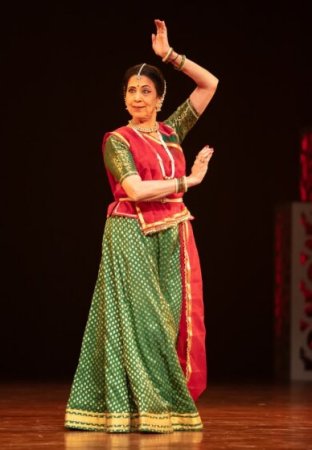 Maneesha Sathe Guru Maneesha Sathe, a senior Kathak exponent from Pune, was the last performer of the second evening. She was initially trained under Pt. Balasaheb Gokhale and later under Pt. Gopi Krishna. She is carrying forward Pt. Gopi's legacy of taking Kathak to the masses, without diluting its essence. She performed a traditional Kathak piece starting with a Dhrupad "Niratat Shiv Girija sung" composed by Chinmay Kolhatkar. In the Taal Anga she went on to perform Ganesh Taal, an 'Anvat' i.e. rare and unique Taal of 21 beats having a melange of traditional pakhavaj compositions, beautifully justifying the 21-beat cycle. As the rasikas watched with awe, she concluded her recital with a soulful bhajan, "Mohe man lagyo chand Govind Govind" composed by Pt. Padmakar Barve. It showed her absolute mastery of abhinaya, taking every subtle emotion and ensuring it reached the rasikas. She was ably accompanied by her team from Pune - Nikhil Phatak on tabla, Rajiv Tambe on harmonium, Jaydeep Vaidya on vocal and her senior disciple Vallarie Apte on padhant. Day three commenced with the solo performance of Sangeeta Chatterjee, a disciple of Bhaswati Mishra and presently a member of the Kathak Advisory Board. Ganesh Stuti was followed by shudh nritta in Taal Pancham Sawari (15 beats time cycle). There was much perfection in her rendition. Thumri "Babul mora naihar chuto jaye" written by Wajid Ali Shah set in raag Bhairavi stole my heart. 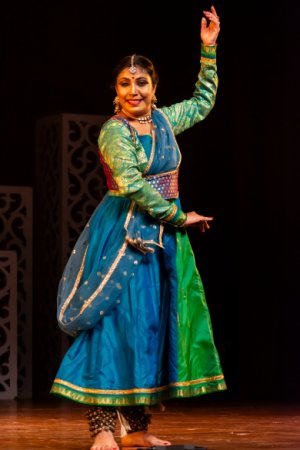 Sangeeta Chatterjee 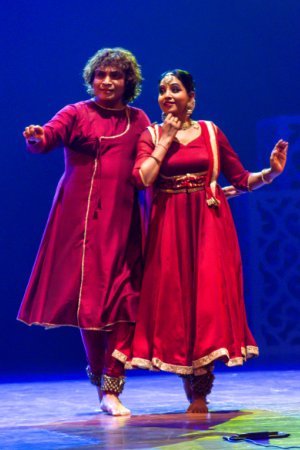 Hari-Chethana Hari-Chethana were the talented duet dancers from Bangalore. The sacred ritual from the Natyashastra symbolising the cleansing of the stage seeking to eliminate all obstacles and invoke the Astadikpalakas such as Lord Indira, Lord Agni, Lord Yama, Lord Nairuta, Lord Varuna, Lord Vayu, Lord Kubera and Lord Eshana was performed first before launching on to the shloka on Lord Krishna from Sri Krishna Karnamrutmam written by the Saint Bilvamangala. A description of Krishna wearing a kasturi tilakam on his forehead and the kaustubha jewel ornaments on his chest; the nava mouktika, a pearl ornament on his nose, with his fingertips gracing the flute, while his wrist is ornamented with a bracelet was rendered. Fragrant sandalwood paste worn by the lord was admired through dance. His blessings were sought. This was backed up with teentaal in Sohini raag; uthaan, tripalli, ladi, tukdas, tihais and parmelu were showcased. There was also a rhythmic jugalbandi between the percussionist and the dancers which was followed by a Sargam in raag Malhar. The second last piece Madhur Madhav, a Swati Tirunal composition in raag Brindavani Sarang describing Krishna's relationship with Radha signified a quest for union with the divine. Shivanjali was the concluding item. Shiva's cosmic dance, the Tandava, represents the rhythm of creation, preservation, and dissolution. His consort Parvati, symbolizes the divine feminine, balancing his intense energy. Devotees seek Shiva's blessings for spiritual growth, inner peace, and liberation from the cycle of life and death. Pandant was by Sirisha, vocal by Praveen Karadagi, tabla by Karthik Krishna, sitar by Sanjeev Korti and flute by Madhucharan. 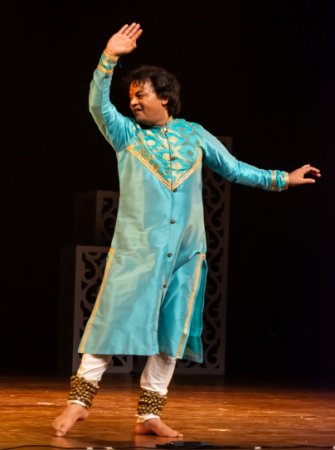 Abhimanyu Lal Abhimanyu Lal set the stage on fire with the piece Shiva-Anant where the lord of dance is an embodiment of creation and preservation. The composition invoking Shiva was in dhrupad style of singing. The dance built up from a heavy base to a filling crescendo, glorifying the attributes of Lord Shiva, his damru, his matted locks, Ganga flowing out of his hair locks, the serpent round his neck. It was composed by Guru Geetanjali Lal in the time-cycle of 12 beats and raag Shankara. Abhimanyu commenced with Shuddha Nritta. Kathak's finest technical nuances in teentaal, the time cycle of 16 beats in vilambit laya was showcased. He started off with some snippets of upaj, improvisation, thaat, uthaan etc., with lightning speed footwork, breathless spins and grandeur of hand gestures. In the shuddha nritta part, he began with upaj and wove some intricate patterns of syllables, finishing it off with a tihaai. Then he moved on to a few thaat. As Pt Durga Lal used to dance a lot of uthaan, so did Abhimanyu. He performed some traditional uthaans composed by Pt. Devi Lal, Pt. Durga Lal and his Guru Geetanjali Lal. He performed a tihaai of 5 laya. Another tihaai which showed the path of aaroh and avroh and called it his "namesake" tihaai, but this Abhimanyu had the knowledge of coming back. Besides the tukda, paran and tihaai, he performed traditional paran, and a chalan that was so smartly designed, that it deliberately skipped the "sam," a difficult feat. He concluded his performance with a rich jugalbandhi with the tabla player Yogesh Gangani. The response of the audience was through thunderous clapping. Abhimanyu Lal dedicated his performance to Pt Durga Lal and as providence had designed, his performance date 31st Jan, was also Pt Durga Lal's death anniversary. Accompanying artistes who matched up to his superb performance were Yogesh Gangani on tabla, Salman Warsi on pakhawaj, Samiullah Khan on vocal, Nasir Khan on sarangi and Varsha Dasgupta on padhant. 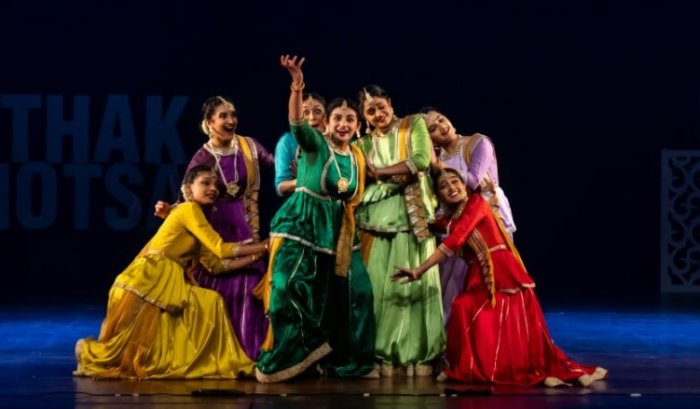 Abhinava Dance Company The grand finale of this excellent festival was by Nirupama and Rajendra's Abhinava Dance Company from Bangalore. Shivastuti was an auspicious invocatory dance to Lord Shiva addressed as Shankara, Mahadeva holding trishula, Kapaala wearing rudramala, playing his damaru. The devotee asked for the blessings of Shiva and danced to his glory. This prayerful song was written and composed by Ustad Faiyaz Khan in raag Hindol and Dhamaar taal. In the brilliant poetry of Krishna Karanamrutham, one of the finest works in Sanskrit literature by poet Leela Shuka, the dancers explore abhinaya from selected verses featuring intricate description, rich imagination, profound thoughts in mellifluous words. The first verse portrayed Vipralambha Shringara (love in separation) of the Gopikas towards Krishna and they together request the flute to communicate their mental state of love for Krishna. In the second verse, the dancers enacted a light hearted episode with little Krishna getting caught stealing butter and his clever management of the situation with his answers to the questions of the Gopika. In the last verse, the Gopikas display authoritative love, chiding Krishna for leaving them all and moving away to Mathura led by Akrura. A bountiful selection performed to the music composition of Praveen D Rao, choreographed by Nirupama and T.D. Rajendra. Vocalist Keertan Holla gave appropriate support. The next piece Tarana celebrated pure dance and was danced lyrically to the melodic syllables of raag Madhukauns, embellished with fast footwork. Music composition was by Ustad Faiyaz Khan. There was good coordination and synchronization amongst the dancers. This piece of writing would be incomplete without focussing on the aspects that gave the festival an all rounded vision of what was and what is and what shape practitioners from different corners are giving to it. It was not a competition of artistes or between them. All that Uma Dogra attempted was to hold a mirror in front of all. Government of India and Sangeet Natak Akademi (Kathak Kendra is a constituent unit of SNA, New Delhi) came forward and assisted her in her endeavour. During the day there were talk shows, seminars and of course exhibitions. The exhibition not only displayed milestone photographs, but also displayed ghungroos, musical instruments, costumes and other personal belongings of the yester year gurus. The festival was dedicated to Pt. Birju Maharaj, Guru Kundan Lal Gangani, Pt. Durga Lal, Pt. Tirath Ram Azad and Pt. Jitendra Maharaj. Their disciples, who are presently eminent teachers and names to reckon with, spoke of their experiences with their gurus. In the seminars, speakers enlightened listeners on selected topics like 'Ang Saundarya' - Aesthetics in body alignment, 'Bandish of Jaipur Gharana' - Rhythmic compositions of Jaipur Gharana and 'Kathak Mei Naveenikaran' - Innovative approach in Kathak. This year, Kathak Mahotsav will be held in Pune and Varanasi too - a path breaking step. 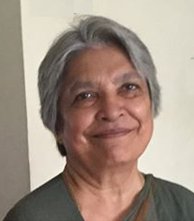 Tapati Chowdhurie trained under Guru Gopinath in Madras and was briefly with International Centre for Kathakali in New Delhi. Presently, she is a freelance writer on the performing arts. |